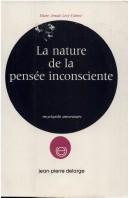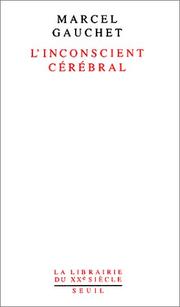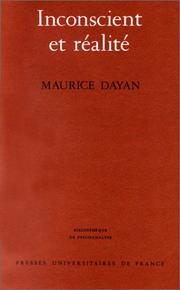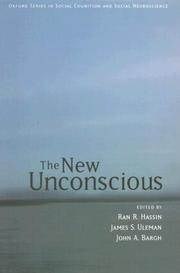| Listing 1 - 10 of 32 | << page >> |
Sort by
|

ISBN: 9782711300440 2711300447 Year: 1978 Publisher: Paris : Jean-Pierre Delarge,
Abstract | Keywords | Export | Availability | Bookmark
 Loading...
Loading...Choose an application
- Reference Manager
- EndNote
- RefWorks (Direct export to RefWorks)
Inconscient. --- Subconsciousness. --- Psychoanalysis --- Subconsciousness --- #GBIB:CBMER --- #gsdbf --- Unconscious (Psychology) --- Unconsciousness --- Psychology --- Psychology, Pathological --- Psychoanalysis.
Book
ISBN: 2700700171 9782700700176 Year: 1975 Publisher: Paris Aubier Montaigne
Abstract | Keywords | Export | Availability | Bookmark
 Loading...
Loading...Choose an application
- Reference Manager
- EndNote
- RefWorks (Direct export to RefWorks)
Symbolism (Psychology) --- Subconsciousness --- Symbolisme (Psychologie) --- Inconscient --- Unconscious (Psychology) --- Unconsciousness --- Psychology --- Symbolism in psychology --- Psychoanalysis --- Subconsciousness. --- Symbolism (Psychology).

ISBN: 2020135485 9782020135481 Year: 1992 Publisher: Paris : Editions du Seuil,
Abstract | Keywords | Export | Availability | Bookmark
 Loading...
Loading...Choose an application
- Reference Manager
- EndNote
- RefWorks (Direct export to RefWorks)
Subconsciousness --- Psychophysiology --- Inconscient --- Psychophysiologie --- History. --- -Unconscious (Psychology) --- Unconsciousness --- Psychology --- History --- -History --- Unconscious (Psychology) --- Cognitieve psychologie. --- Neuropathologie. --- Subconsciousness - History.
Book
ISBN: 204729942X 9782047299425 Year: 2004 Publisher: Paris : Bordas,
Abstract | Keywords | Export | Availability | Bookmark
 Loading...
Loading...Choose an application
- Reference Manager
- EndNote
- RefWorks (Direct export to RefWorks)
Subconsciousness --- Psychoanalysis and philosophy. --- Inconscient --- Psychanalyse et philosophie --- Philosophy. --- Philosophie --- Psychoanalysis and philosophy --- Philosophy and unconsciousness --- Psychoanalysis

ISBN: 2130389988 9782130389989 Year: 1985 Publisher: Paris : Presses Universitaires de France,
Abstract | Keywords | Export | Availability | Bookmark
 Loading...
Loading...Choose an application
- Reference Manager
- EndNote
- RefWorks (Direct export to RefWorks)
Psychoanalysis --- Reality --- Subconsciousness --- Psychotherapy --- Psychagogy --- Therapy (Psychotherapy) --- Mental illness --- Clinical sociology --- Mental health counseling --- Unconscious (Psychology) --- Unconsciousness --- Psychology --- Philosophy --- Truth --- Nominalism --- Pluralism --- Pragmatism --- Psychology, Pathological --- Treatment
Book
ISBN: 2010053583 9782010053580 Year: 1978 Publisher: [Paris] : Hachette,
Abstract | Keywords | Export | Availability | Bookmark
 Loading...
Loading...Choose an application
- Reference Manager
- EndNote
- RefWorks (Direct export to RefWorks)
Subconsciousness --- Thought and thinking --- Subconsciousness. --- Thought and thinking. --- Mind --- Thinking --- Thoughts --- Educational psychology --- Philosophy --- Psychology --- Intellect --- Logic --- Perception --- Psycholinguistics --- Self --- Unconscious (Psychology) --- Unconsciousness

ISBN: 0195307690 9780195307696 9780195149951 0195149955 Year: 2005 Publisher: New York : Oxford University Press,
Abstract | Keywords | Export | Availability | Bookmark
 Loading...
Loading...Choose an application
- Reference Manager
- EndNote
- RefWorks (Direct export to RefWorks)
Subconsciousness --- Unconscious (Psychology) --- Volition. --- Subconsciousness. --- Inconscient --- sociale cognitie --- sociale cognitie. --- Unconsciousness --- Psychology --- Cognitive psychology --- Sociale psychologie --- Cognition. --- Emotions. --- Perception. --- Social Behavior. --- Unconscious, Psychology.
Book
ISBN: 9782889194209 Year: 2015 Publisher: Frontiers Media SA
Abstract | Keywords | Export | Availability | Bookmark
 Loading...
Loading...Choose an application
- Reference Manager
- EndNote
- RefWorks (Direct export to RefWorks)
To what level are invisible stimuli processed by the brain in the absence of conscious awareness? It is widely accepted that simple visual properties of invisible stimuli are processed; however, the existence of higher-level unconscious processing (e.g., involving semantic or executive functions) remains a matter of debate. Three major factors may underlie the discrepancies found in the literature: 1) different levels of conservativeness in the definition of “unconscious;” 2) different dependent measures of unconscious processing; and 3) inherent differences in the amount of information let through by different suppression techniques. In this research topic we are particularly interested in the third factor.Researchers using visual masking and researchers using interocular suppression disagree on the extent of unconscious processing as measured by priming effects. On the one hand, the community of researchers using visual masking seems to have reached the consensus that “subliminal priming has now been convincingly demonstrated at visual, semantic, and motor levels” (Dehaene and Changeux). On the other hand, in an influential review, Blake and Logothetis claimed that for high-level cognitive processes, “[interocular] suppression renders normally effective priming stimuli impotent“. Stein and Sterzer came to similar conclusions in a more recent contribution. However, these claims are challenged by empirical evidence for unconscious processing under interocular suppression using other dependent variables, e.g., conditioning and perceptual learning. Hence, the picture is not as clear cut as priming studies may suggest.Neuroimaging studies (e.g., functional MRI) offer another window on the extent of unconscious processing. Kouider et al. found that faces masked with a combination of forward and backward pattern masks elicited a BOLD response in the Fusiform Face Area (FFA). Jiang and He also reported that the fusiform face area (FFA) was active in response to faces rendered invisible by continuous flash suppression. Though Sterzer, Haynes and Rees did not replicate this finding with univariate analyses, they could discriminate invisible faces from invisible houses in the fusiform face area using multivariate pattern analysis. Thus it appears that there is unconscious processing of invisible faces in the FFA whether visual masking or interocular suppression is used; the amount of processing may differ between the two techniques, as suggested by the necessity of performing decoding when interocular suppression is used.In the same conditions of well-controlled, conservatively established subjective invisibility, can we show that some of the techniques in the “psychophysical magic” arsenal (e.g., masking, but also visual crowding, attentional blink, etc.) reliably lead to higher-level unconscious processing than others (e.g., interocular suppression)? Some authors have started investigating this question, using multiple techniques in similar settings . We argue that this approach should be extended. Indeed, in order to delineate the frontiers of the unconscious mind using a contrastive method, one has to disentangle the limits attributable to unawareness itself, and those attributable to the technique inducing unawareness. The scope of this research topic is to provide a platform for scientists to contribute insights and further experiments addressing this fundamental question.
Subconsciousness. --- Unconscious (Psychology) --- Unconsciousness --- Psychology --- Continuous Flash Suppression (CFS) --- psychophysical magic --- unconscious processing --- visual crowding --- backward masking --- measures of consciousness --- interocular suppression --- invisibility
Book
ISBN: 2130479545 9782130479543 Year: 1997 Volume: *3 Publisher: Paris : PUF - Presses Universitaires de France,
Abstract | Keywords | Export | Availability | Bookmark
 Loading...
Loading...Choose an application
- Reference Manager
- EndNote
- RefWorks (Direct export to RefWorks)
Inconscient --- Onbewuste --- Onderbewuste --- Onderbewustzijn --- Subconscient --- Subconsciousness --- Unconsciousness --- Transference (Psychology) --- Reason --- Transfert (Psychanalyse) --- Raison --- Psychological aspects --- Aspect psychologique --- Irrationalism (Philosophy) --- Logique --- Psychanalyse et philosophie --- Clivage (psychologie) --- Irrationnel (philosophie) --- Mecanismes de defense --- Rationalisation (psychologie) --- Symbolisme (psychologie) inconscient
Book
ISBN: 0894950207 9780894950209 Year: 1982 Publisher: London ; New York, NY ; Rheine : ISI (Institute for Scientific Information) (Press),
Abstract | Keywords | Export | Availability | Bookmark
 Loading...
Loading...Choose an application
- Reference Manager
- EndNote
- RefWorks (Direct export to RefWorks)
Subconsciousness --- Psychology --- Science --- Inconscient --- Psychologie --- Sciences --- Philosophy --- Philosophie --- -Science --- -Subconsciousness --- Unconscious (Psychology) --- Unconsciousness --- Natural science --- Science of science --- Behavioral sciences --- Mental philosophy --- Mind --- Science, Mental --- Human biology --- Soul --- Mental health --- Normal science --- Philosophy of science --- Psychology - Philosophy --- Science - Philosophy
| Listing 1 - 10 of 32 | << page >> |
Sort by
|

 Search
Search Feedback
Feedback About
About Help
Help News
News